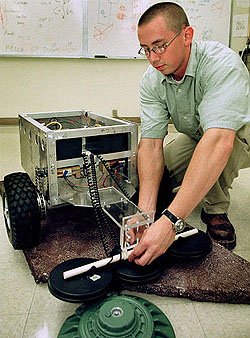|
Making robots people friendly
 |
| Carnegie Mellon University research assistant Brian Hargrave makes an
adjustment to a robot which is designed to search for land mines. (AP) |
PITTSBURGH (AP) -- Scientists are learning to make robots that do what they're supposed
to do when they're supposed to do it. Now if only human beings would play along.
Researchers from all over the world gathered Sunday at Carnegie Mellon University to show
each other the latest in robots made to help their human masters.
One common problem: making the programmed machines work alongside unpredictable human
nature.
For example, a team of scientists at Carnegie Mellon is working on robots that serve as
museum guides. The technology could eventually be used to build robot nurses.
But kids at the Smithsonian Institution in Washington, D.C., had other ideas when a robot
named Minerva debuted there last summer -- they jumped on Minerva and tried to take it for
a ride.
To make sure people respected Minerva's space, designers gave it a voice and moving mouth
and eyebrows.
''I need to get through,'' the robot said, frowning at Smithsonian guests who dawdled in
front of it. Minerva smiled at those who moved.
People responded, said Sebastian Thrun, a Carnegie Mellon assistant computer science
professor working on the museum robots.
Thrun's conclusion: People like it when machines interact with them. Now he's using that
theory when building other robots.
Most of the technology spotlighted Sunday is not yet available commercially, but
researchers are hopeful. Among those looking for corporate sponsorship was Gerard Lacey, a
designer from Ireland's Trinity College. His team tested robots to help blind and elderly
people who don't have the strength to walk with canes or guide dogs.
The robot, which resembles a lawn mower, allows blind people to walk holding its handles
for support. They point the robot in the direction they want to go, and its built-in
sensors slow it down and stop it from hitting walls.
The robot became popular quickly at a nursing home where it was tested.
''Life in a nursing home is very regimented,'' Lacey said. ''There's a time for bingo,
there's a time for tea. There's a time for whatever. Now there was a time to walk around.
They guarded it very jealously.''
Meeting older people's needs called for some adjustments, Lacey said. At one point the
robot had a joystick like those used in arcade games, which had to change.
''Elderly people have never used a joystick in their life,'' he said. ''It's probably not
going to be a successful interface for them.''
Other robots unveiled Sunday included a wheelchair that automatically finds its way
through shifting crowds. Once the chair is programmed to move in a given direction, the
person sitting in it can ride with hands folded as the chair charts the movements of
people nearby, chooses a path around them and moves at normal walking speed.
Another robot tracked people's eye movements. One of the designers, Alex Zalinski of
Australian National University, said it could be used in cars to make sure drivers are
keeping their eyes open and on the road, even if they move their heads or change the
lighting in the car.
Copyright 1999 Associated Press. All rights reserved. This material may not be published, broadcast, rewritten or redistributed.
|





